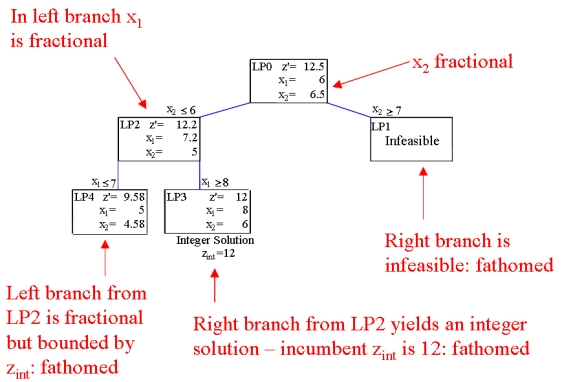Integer Programming
Integer programmes are almost identical to linear programmes with one very important exception. Some of the decision variables in integer programmes can only have integer values. The variables are known as integer variables. Since most integer programmes contain a mix of real variables (i.e., that can have any real value) and integer variables they are often known as mixed integer programmes. While the change from a linear programming formulation is a minor one, the effect on the solution process is enormous. Integer programmes can be very difficult problems to solve and currently a lot of research is focussing on finding "good" ways to solve integer programmes. Integer programming, the process of solving a (mixed) integer programme, was originally done using the branch-and-bound process. The branch part of the process eliminated non-integer values for integer variables in the following way:- Initially, all variables are left as real variables. The problem is solved using linear programming;
- If one of the integer variables in the linear programming solution has a fractional value, e.g.,
 , then the linear programme is split in two and the fractional region eliminated. This is done by branching on the variable value to get two new linear programmes, e.g., adding the constraint
, then the linear programme is split in two and the fractional region eliminated. This is done by branching on the variable value to get two new linear programmes, e.g., adding the constraint  to form one linear programme and
to form one linear programme and  to form the other.
to form the other.
- By finding the optimal solution in each of these new linear programmes and comparing we can find the optimal solution for the original problem;
- If either of the new linear programmes has a fractional value for an integer variable then a new branch is needed.
- The linear programme is infeasible (no more branching is possible);
- The linear programme solution is an integer solution with a better objective value than the incumbent. The incumbent is replaced with this new solution;
- The linear programme solution has an equal or worse objective than the incumbent. Any nodes created from this node will also have an equal or worse objective than the incumbent. This node is bounded by the incumbent objective;
- The linear programme solution is fractional and has a better objective value than the incumbent. Further branching from this node is necessary to ensure an optimal solution is found.

Integer Programming Topics
Integer Programming with OR Software
To see integer programming in action, check out some of the integer programming case studies:Results from OpsRes web retrieved at 03:46 (GMT)
\usepackage{amsmath} Case Study: Submitted: Operations Research Topics: Application Areas: Contents Problem Description Problem Description Return...
\usepackage{amsmath} Case Study: Submitted: Operations Research Topics: Application Areas: Contents Problem Description Problem Description Return...
\usepackage{amsmath} Case Study: Submitted: Operations Research Topics: Application Areas: Contents Problem Description Problem Description Return...
\usepackage{amsmath} Case Study: Submitted: Operations Research Topics: Application Areas: Contents Problem Description Problem Description Return...
\usepackage{amsmath} Case Study: Submitted: Operations Research Topics: Application Areas: Contents Problem Description Problem Description Return...
\usepackage{amsmath} Case Study: Submitted: Operations Research Topics: Application Areas: Contents Problem Description Problem Description Return...
\usepackage{amsmath} Case Study: Submitted: Operations Research Topics: Application Areas: Contents Problem Description Problem Description Return...
\usepackage{amsmath} Case Study: Submitted: Operations Research Topics: Application Areas: Contents Problem Description Problem Description Return...
\usepackage{amsmath} Case Study: Submitted: Operations Research Topics: Application Areas: Contents Problem Description Problem Description Return...
\usepackage{amsmath} Case Study: Submitted: Operations Research Topics: Application Areas: Contents Problem Description Problem Description Return...
Number of topics: 10
-- TWikiAdminGroup - 20 Feb 2008 Topic revision: r23 - 2018-11-23 - TWikiAdminUser
Ideas, requests, problems regarding TWiki? Send feedback

